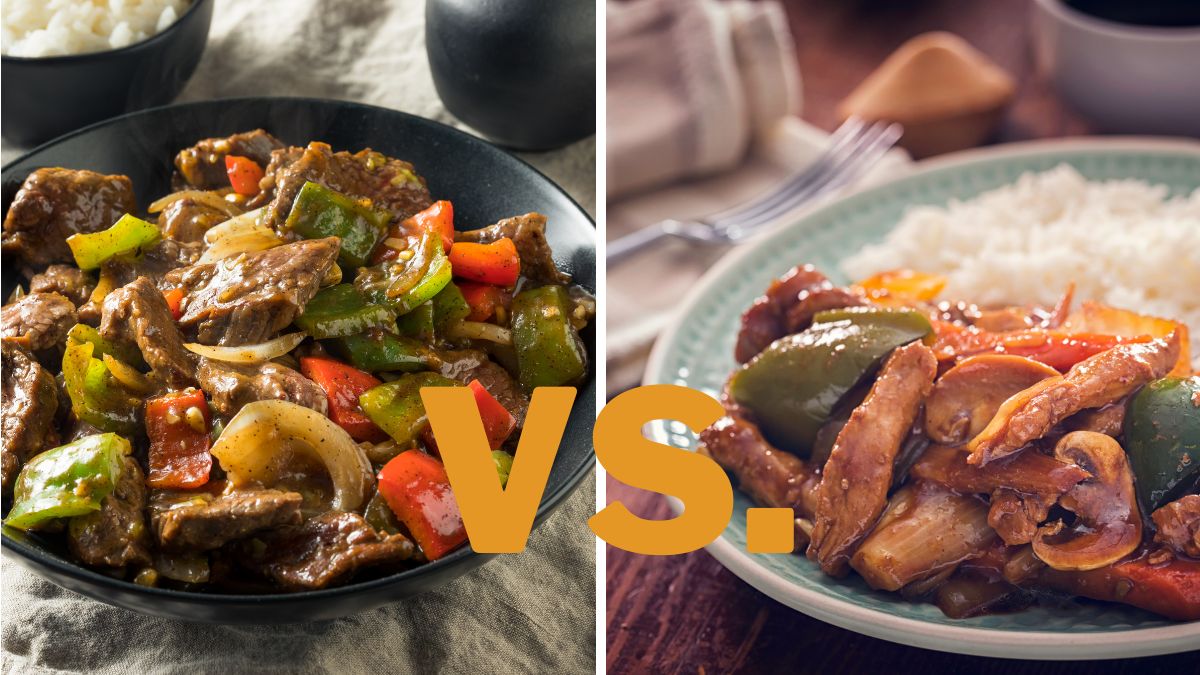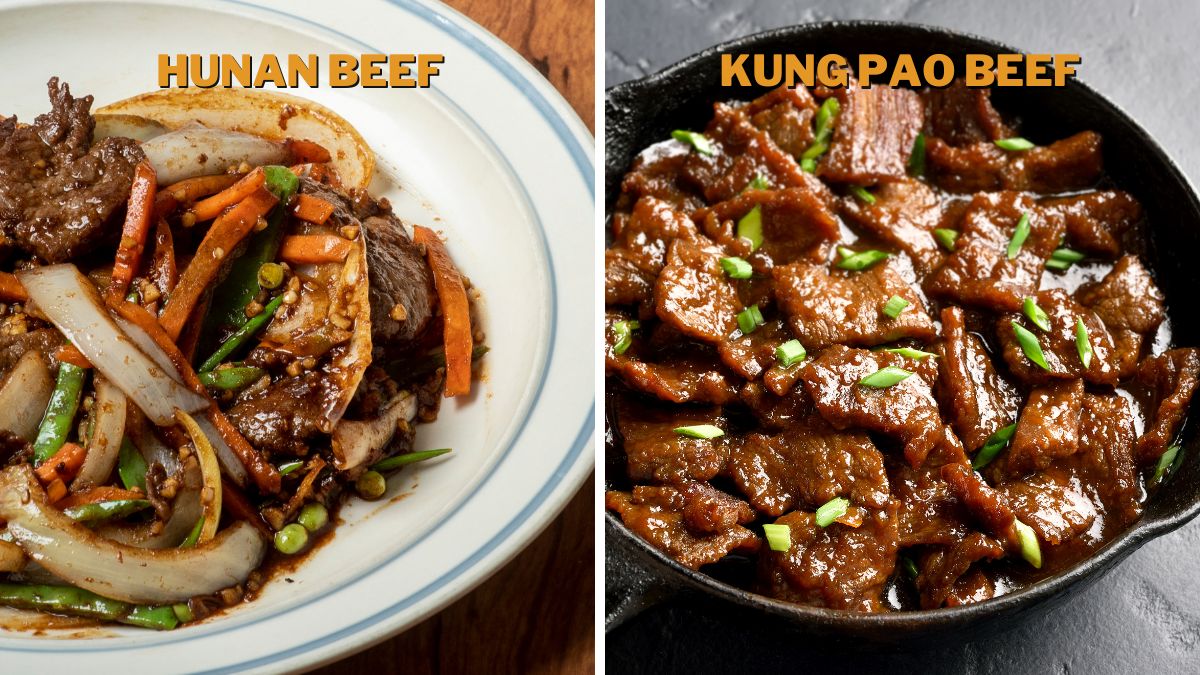Hunan Beef vs. Kung Pao Beef: Differences & Which Is Better?

Asian cuisine has many delicious dishes, but few are as beloved as Hunan and Kung Pao beef. Both stir-fried meals originated in China and have become popular worldwide – but people often wonder what makes them different. So, what is the difference between Hunan and Kung Pao beef?
Hunan beef is made with a sweet and spicy sauce and served with a crunchy top, while Kung Pao beef is made with a sweet, sour, and spicy sauce and a sprinkle of peanuts. Hunan beef is usually served as part of a multi-course meal or stir-fried plate with veggies or side dishes, whereas Kung Pao typically stands alone.
Ultimately, it’s up to your individual preference which beef dish you prefer – both offer their own unique flavor and texture. While both Hunan and Kung Pao beef dishes are delicious, there is no single answer regarding which one is better. If you’re looking for a tasty new dish to try or just curious about the flavors of each one, this article is for you.
Differences
I’ll break down the differences between my two beloved Chinese beef-based meals and talk about their ingredients and preparation styles, how they look and taste different, the way they’re served, their popularity, similarities with other dishes, and even which one is better!
Join me as we explore the fascinating characteristics of these two delicious Chinese dishes.
Ingredients and Preparation
When it comes to the ingredients and preparation of Hunan beef and Kung Pao beef, there are both similarities and differences.
The main similarity between the two is that both feature tender slices of beef as the star ingredient. However, when it comes to flavor, that’s where their differences start.
For Hunan beef, the marinade usually consists of soy sauce, Shaoxing cooking wine, dark soy sauce, sesame oil, sugar, ginger, and garlic. The beef is stir-fried at high heat with chili peppers and other vegetables like diced celery or carrots for added crunch.
Kung Pao beef also uses ginger and garlic for flavor, but its marinade uses various ingredients like cornstarch, sugar, and Chinkiang vinegar. The beef is stir-fried at high heat with chili peppers but is almost always served with nutty elements like peanuts or cashews to balance the flavors.
Appearance and Taste
Kung Pao beef is often cooked in a bright red sauce with a sweet chili flavor. Its most defining characteristic is its crunchiness due to peanuts or cashews added during cooking. Still, some versions do not contain nuts.
The Hunan version of this dish typically features a darker reddish-brown color as it’s cooked with more spices and chilis than its counterpart, making it slightly spicier than Kung Pao beef. It has that characteristic spicy heat that’s associated with Sichuan cuisine, along with hints of sweetness from garlic or scallions.
The sauce is thick, and the heat level can range anywhere from mild to extremely spicy, depending on how it’s prepared.
While Kung Pao beef is similar in terms of color, it has a much thinner sauce that usually has some peanut flavor to it. It also tends to be spicier than its Hunan counterpart. But here’s the catch: Each restaurant can season the ingredients differently, so what you get isn’t always what you expect!
Fans of Kung Pao beef will tell you that this dish is all about balance: The chilies bring the heat, but they’re complemented by the sweetness of the vegetables and the saltiness of the peanuts.
On the other hand, Hunan beef tends to focus more on bold flavors like garlic and scallions. But in either case, these dishes definitely pack a punch!
Serving Style
Serving style is a slight distinction between Hunan beef and Kung Pao beef. Hunan beef is a very hot dish, so it is most often served over steamed or fried white or brown rice or thick noodles.
Regarding Kung Pao beef, it can also be served over fried rice in a stir-fry style. Since it often contains peanuts, it is excellent as a single-dish option, so you don’t actually need anything to accompany it. This makes a difference, both in terms of presentation and overall flavor.
If you’re looking for a more complex flavor profile, then choosing Hunan beef might be the better option. The accompaniments of steamed or fried rice and vegetables bring out the dish’s flavors while complementing it perfectly.
On the other hand, if you’re looking for a simpler dish, then Kung Pao might be your best bet. Kung Pao beef is typically prepared with celery and peanuts, then served with jasmine rice. Meanwhile, Hunan beef is usually served as a main course over a bed of vegetables or rice – this is my favorite way of having it because the rice balances out the flavors of the beef.
Popularity and Variations

When it comes to Hunan beef and Kung Pao beef, one thing is sure – both dishes are very popular around the world.
Generally speaking, Hunan beef is more popular than Kung Pao beef in mainland China and other Asian countries. However, both dishes have seen increased popularity worldwide due to their unique taste profiles, with many restaurants offering their own variations of each dish.
Hunan beef is generally considered a traditional Chinese dish, as its origin can be traced back to the Hunan province of China. It is often served in its original form with little variation.
However, that doesn’t mean there are not some slight variations, like adding sesame seeds, peanuts, onions, or mushrooms.
On the other hand, Kung Pao beef has been adapted to different regions and cultures, resulting in variations that have become popular in their own right. For example, there’s Japanese yasai katsu don, which uses bell peppers and meat cutlets instead of traditional Kung Pao ingredients, or the Thai version with red chili paste instead of chili bean sauce.
Kung Pao beef has reached global popularity due to its adaptations to different cultures and cuisines. However, Hunan beef remains more widespread in its country of origin – it’s a common sight on restaurant menus all over China.
Similarities with Other Dishes
Reviewing Hunan beef and Kung Pao beef without mentioning their similarities with other Chinese dishes would be unfair. Both dishes have similarities with other Chinese dishes such as Mongolian beef, Szechuan beef, or orange beef.
However, what makes them unique is the fact that they originate from two distinct provinces in China: Hunan and Sichuan, respectively.
Szechuan beef is characterized by its spicy peppers, orange beef is often made with a batter fried until it’s crispy, while Mongolian beef has the mildest flavor. All of these dishes bear some resemblance to Hunan and Kung Pao beef. But, while these dishes may have similar ingredients, their preparation and taste are distinct from each other.
For example, Hunan and Kung Pao sauces are sweeter than the sauce in Szechuan beef, which has spicy Sichuan peppers as its prominent flavor, as well as a chili bean sauce. As for orange beef, the inclusion of orange juice or zest sets it apart from Hunan or Kung Pao beef, which are primarily made with minced garlic, ginger, and chili peppers, among other ingredients.
So while there may be similarities among these dishes, they are unique in their own ways concerning ingredients and preparation techniques.
Which Is Better, Hunan Beef or Kung Pao Beef?
Ultimately, when it comes down to choosing between Hunan beef and Kung Pao beef, it mostly boils down to personal preference. However, I think that both dishes have their respective upsides and downsides.
Hunan beef is similar to other Hunan-style dishes like the common General Tso chicken, with its pronounced spicy flavor and a strong sauce that can be smelled across the room. The ingredients include soy sauce, garlic, chilis, and the star ingredient: beef. These ingredients are combined to form a savory sauce and then poured over thinly sliced beef.
Meanwhile, Kung Pao beef uses roasted peanuts as a main ingredient as well as garlic and chili peppers for seasoning. It has a unique sweet yet spicy flavor from the use of sugar and vinegar, which can be very refreshing on the taste buds. However, it does contain a lot of sugar and oil if you’re watching your diet.
So, both dishes have a savory flavor and a hint of spicy kick due to the chili peppers used in their preparation. However, while Kung Pao beef has a more balanced flavor profile due to its combination of sweet, sour, salty, and hot elements, Hunan beef has a bolder taste because it generally contains more chilies than its counterpart.
Both dishes provide delicious flavors and textures that will tantalize your taste buds. Whether you choose Hunan beef or Kung Pao beef simply depends on which flavor profile you prefer!
